| |
Home ↔
How Transformers, Chokes and Inductors Work, and Properties of M
How Transformers, Chokes and Inductors Work, and Properties of M
| |
How
Transformers, Chokes and Inductors Work, and Properties of Magnetics |
| |
The
magnetic properties are characterized by its hysterisis loop, which is
a graph of flux density versus magnetization force as shown below: |
| |
|
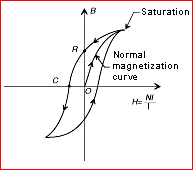
Hysterisis Loop
|
|
| |
When
a electric current flows through a conductor ( copper wire), it generate
a magnetic field. The magnetic field is strongest
at the conductor surface and weakens as its distance from the conductor
surface is increased. The magnetic field is perpendicular to the direction
of current flow and its direction is given by the right hand rule shown
below.
| |
| |
|
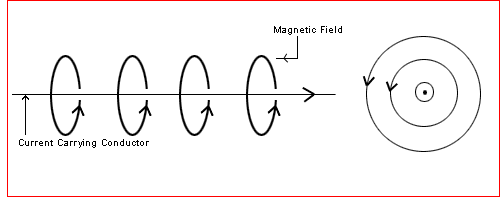
|
|
| |
When the conductor
or wire is wound around a magnetic materials ( ferrite, nanocrystalline, amorphous, iron, steel,
MPP, sendust, high flux, mega flux, etc), and current flows through the conductor,
a flux is induced on the magnetic materials. This flux is induced by
the magnetic field generated by the current carrying conductor. The
magnetic material's atomic parts got influenced by the magnetic field
and causes them to align in a certain direction.
The application
of this magnetic field on the magnetic materials is called magnetization
force. Magnetization force is called Oersted or A/m (amperes per meter).
The units for Magnetization
force is "H"
The results of applying
these magnetic field from the current carrying conductor causes the
magnetic materials to have magnetic flux being formed inside the magnetic
materials. The intensity of these flux is called flux density. Therefore
flux density is defined as the flux per square area.
Flux density is
called gauss or Tesla. One Tesla is10,000 gauss, or 1mT is 10 gauss.
The unit for Flux
is "B" . Bmax is the maximum flux density.
Thus, the hysterisis
loop is often called the BH curve. Understanding of the BH curve is
extremely important in the designs of transformers, chokes, coils and
inductors.
For a square wave
application as in SMPS, the Flux density or B (in Gauss) is given as: |
| |
|

|
|
| |
If the waveform is sine wave instead of a square wave, the the constant '4' (for square wave) is replaced with '4.44' (for sine wave).
Note that B is a
function of voltage ( input voltage if calculated from primary windings,
and output voltage if calculated from secondary side). Flux will reduce
if you increase the number of turns, increase the switching frequency
or increasing the size of the cores ( increasing the area)
The magnetization
force or H (in Oersted) is given as: |
| |
|

|
|
| |
In the formula above, H is in Oersted. To convert Oersted to A/cm, use the conversion : One A/cm = 0.7958 Oersted.
Note that H is a
function of input current. As the current swings from positive to negative
the flux changes as well, tracing the curve.
The permeability
of a magnetic material is the ability of the material to increase the
flux intensity or flux density within the material when an electric
current flows through a conductor wrapped around the magnetic materials
providing the magnetization force.
The higher the permeability,
the higher the flux density from a given magnetization force and the faster the magnetic material will saturate.
If you look at the
BH loop again, you will note that the permeability is actually the slope
of the BH curve. The steeper the curve, the higher the permeability
as shown below. |
| |
|
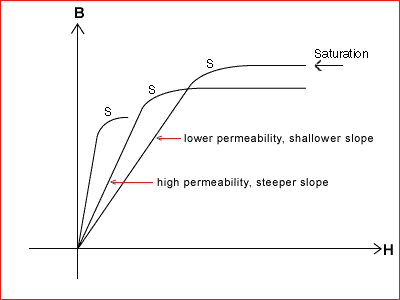
|
|
| |
As the magnetization
force increases ( or the current over the conductor is increased), a
point is reached where the magnetic material or core will saturate.
See point "S" above on the curves. When that happens, any
further increase in H, will not increase the flux. More importantly,
the permeability goes to zero as the slope now is flat. In this situation
the magnetic material or core will fail to work as a transformer, chokes,
or inductors.
So, it is very important
in a choke or inductor design, not to drive the core into saturation
by increasing the current (AC or DC). Usually it is the DC current that
saturate the cores since it is a constant current, and puts the cores
to a certain flux level.
In a transformer
design, you must make sure that the maximum AC current swings from positive
to negative is well below the saturation point.
Another way to
get saturation is by increasing the flux density which is normally achieved
by increasing the voltage ( see equation above). |
| |
|
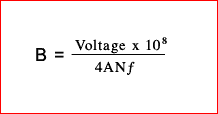 |
|
| |
From the BH curve,
you can see that when the permeability is high ( slope is steep), the
cores will go into saturation faster. Conversely, when the permeability
is low, the cores saturate at a much higher flux density.
Power ferrite cores
normally have a permeability of about 2000, and they saturate faster
than iron powder or MPP cores where the permeability of Iron Powder
or MPP core is 125 or so.
The typical saturation
flux density of Power Ferrite material is under 4000 gauss (400mT).
Whereas the saturation flux density of MPP material is 7000 gauss. High
Flux is 15,000 gauss and Iron Powder is 10,000 gauss.
A transformer is
an energy transfer device, so you want to have minimum losses when you
transfer energy from primary side to secondary side. This is why a ferrite
cores is used.
In a choke or inductor
design, the application is for energy storage, and there is always a
DC current flowing through, so you want to use a iron powder, MPP, sendust
or high flux cores. Also, the saturation flux is a lot higher, so a
higher DC current can flow through. |
| |
Core
Losses
There are always
energy losses in transformers and chokes. These energy losses will generate
heat and cause thermal problems. The losses in a transformer, chokes
or inductors are from the following sources:
- Hysterisis loss
from the sweeping of flux from positive to negative and the area enclosed
by the loop is the loss. Hysterisis loss is due to the materials intrinsic
properties due to the energy used to align and re-align the magnetic
domains. You can lower this loss by using a more expansive materials
such as TDK PC 44, for example.
- Eddy current
loss from the circulating currents within the magnetic materials due
to differential in flux voltage inside the cores itself. This loss
is high dependent upon the thickness of the walls of the cores. The
higher the switching frequency, the higher will be this eddy current
loss.
- Copper or winding
loss. This is also dependent on the wire size, switching frequency,
etc. Skin effect and proximity effect will contribute to this loss.
Our engineers are
experts at selecting the right types of materials, designs and analysis
for your particular application.
|
| |
|
Home ↔
How Transformers, Chokes and Inductors Work, and Properties of M
|
|
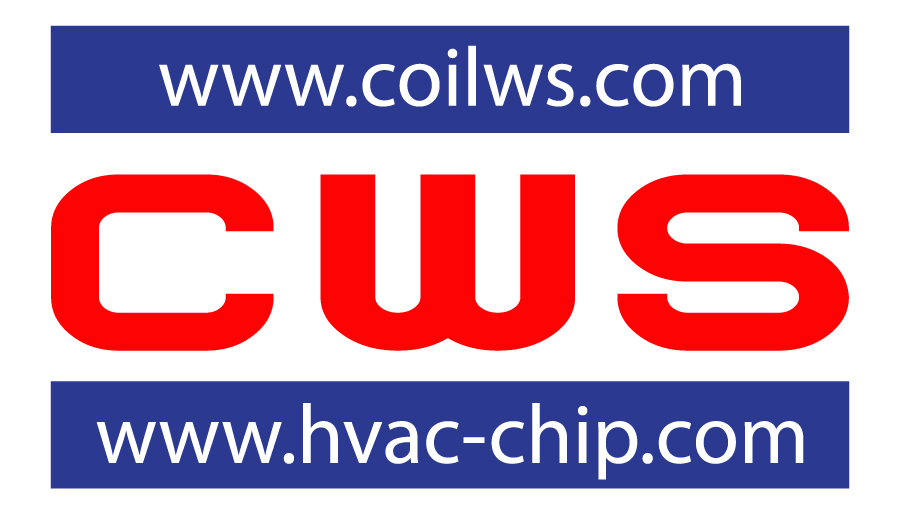




![]()
![]()
![]()
![]()







